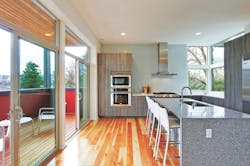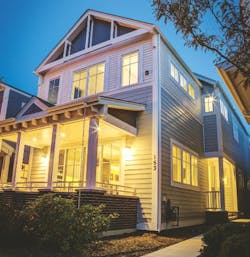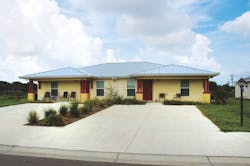Up to the Challenge
The U.S. Department of Energy began recognizing homes built at least 30 percent above code in February 2008 with the creation of Builders Challenge, a voluntary program that certified houses based on a standardized energy rating system. The initiative achieved more than 14,000 verified houses in four-plus years but lacked the teeth to ensure that each participating builder consistently incorporated and promoted the latest solutions produced by research programs such as the DOE’s Building America.
In June 2011, the DOE turned over its building technologies program to Sam Rashkin, who had directed Energy Star for Homes—the industry’s oldest and largest national residential rating system—at the Environmental Protection Agency since that program’s inception in 1995. Rashkin established the latest version of EPA’s Energy Star for Homes as a mandatory underpinning and revamped Builders Challenge to create Challenge Home, a new initiative targeting houses so efficient—called zero net-energy ready—that many can offset all or most of their annual consumption with the installation of renewable energy systems.
“Building America is churning out so many important innovations regarding technologies and best practices,” says Rashkin, a licensed architect. “We want to provide a market solution for getting those innovations into the industry.” Challenge Home improves upon its predecessor because the program identifies proven building science and assures consumers energy-efficient systems as opposed to just parts or points. “You can bank what you’re getting with this label,” he adds.
The beginning
Photo courtesy of Dwell Development
The DOE released Challenge Home specifications in January; approximately 300 builders have signed on as partners, with seven or eight production firms pledging 100 percent of their construction, some builders committing to multi-unit developments, and others choosing to do just one or two homes, Rashkin says. More than 150 houses have been certified by the program already, he adds.
StreetScape Development, a company based in Libertyville, Ill., focused on urban infill, upgraded one of the homes in its School Street community to meet Challenge Home specifications. After finishing the house in April and immediately seeing the value for its owners, the builder made an important decision about its next infill site in Skokie, Ill. “We’ve made the commitment to do the entire project to the U.S. Department of Energy Challenge Home standard,” says owner John McLinden.
The special connection the industry and consumers seem to have with this level of performance became apparent when Houze, a technology development company in Houston, received more than 4,000 phone calls after airing a special on Bloomberg TV about Challenge Home, says Rashkin. “We have one-fourth the budget, one-fourth the staff, and one-fourth the time of Energy Star for Homes, and we’ve gotten to 8,000 homes committed,” he adds.
But, according to many companies, Builders Challenge had difficulty gaining brand recognition in the marketplace, which could foreshadow a similar uphill climb for Challenge Home. “By far the biggest issue for us will always be the message to consumers and the sales techniques to consumers. That’s where we think the industry has been really lagging in terms of figuring out that part of it,” Rashkin says. “They adapt to the technical part but the marketing is more difficult.”
Builders possess the skills and access to cutting-edge materials necessary for the proliferation of energy-efficient, healthy, and durable homes, but communicating the benefits to prospective buyers and possible changes in the transaction process to value high-functioning houses will prove key. “We eventually need the industry to figure out how to have a market-based price for the mortgage attached to an ultra-high-performing home,” Rashkin says.
The standard
Photo courtesy of Quintin McGrath and StreetScape Development
Challenge Home requires builders to comply with Energy Star Version 3 and pass inspection checklists governing the home’s thermal enclosure, HVAC system, water management, and target size. The program then extends beyond Energy Star and mandates all ductwork be placed inside conditioned space; in fact, Rashkin recently attended a training class in Phoenix and marveled at the number of residences still pumping 55-degree air conditioning into a 140-degree attic eight months of the year. “It’s such an insane way to build a product. No other industry has that amount of inefficiency built into it,” he says.
The DOE also stipulates that builders follow certain guidelines from the EPA’s Indoor airPLUS checklist, which includes ventilation, moisture control, pollutant control, and testing intended to improve indoor health. Spending all of that time, money, and effort to build a high-performance home would be futile if it can’t easily adapt to future codes, so Challenge Home ultimately calls for the house to be fitted for potential renewable energy systems such as photovoltaics. “Even an Energy Star home in many markets will be illegal to build in two or three years because it’s pegged to the 2009 code,” Rashkin says.
The decision to link the DOE’s new initiative with Energy Star for Homes affords Rashkin a better chance of attracting builders to Challenge Home because many of them have participated in the EPA’s flagship program at some point; furthermore, many companies already build beyond the Energy Star standard and see Challenge Home as the logical progression of that program.
“We found out that there were just one of two minor tweaks we had to do, but basically all of our homes fit the criteria,” says Tom Wade, owner of Palo Duro Homes, Albuquerque, N.M., which has built 60-plus certified houses in the program, the most of any builder. Wade and his father have been involved with the DOE since 1998 and followed Rashkin to Challenge Home after they thought Builders Challenge had become too “vanilla.” The company only had to lengthen its hot water lines and increase volume in them to comply with the DOE’s new initiative.
In Bradenton, Fla., construction manager Bruce Winter sought to change the way he and his volunteers built homes for low-income families as part of Manatee Habitat for Humanity. The organization, which had been constructing wood frame houses, decided to use ICF block because it can withstand 150 mph winds, offers better wall insulation, and gives them nearly a third of the points needed to reach the Challenge Home standard.
Winter says Manatee didn’t encounter much trouble constructing a home to the DOE’s specifications in Ellenton, Fla., because of the work the organization did on the front end. “It’d be very difficult to take a house plan and then try to adapt it to make it a Challenge Home,” he adds. For example, the size of the ICF block dictated Manatee’s new home design so that the group could lay a continuous rectangle of block without making a cut, which prevents waste and saves money.
Manatee doesn’t have to market its energy-efficient homes to prospective buyers, but the organization does have to show its donors that their money is being put to good use, and certification programs help convince them, Winter says.
The obstacle
Photo courtesy of Manatee Habitat for Humanity
Many builders encounter difficulty selling high-performance homes because of the premium buyers must pay to help cover the added cost of energy-efficient considerations. The DOE says the extra expense to build a house to the level of Challenge Home is about $5,000 to $7,000 above the 2009 energy code, according to Rashkin, and most builders seem to agree the difference resides around 8 percent of the purchase price.
Meritage Homes, one of the largest builders in the country, started pushing energy-efficient building technology about five years ago and decided to market the features to customers. “We tried to make buyers understand building science and failed miserably at it,” says C.R. Herro, vice president of energy efficiency with the Scottsdale, Ariz., builder. “What we’ve learned is that it’s not the features of a green-building program but the benefits of a green-building program that you have to help consumers understand.”
Meritage incorporated learning centers in their model homes to show consumers how the components of an energy-efficient house translated into assets; for example, buyers can remove a piece of a wall, ceiling, or window and see just how much heat passes through different materials. “Making somebody aware that they could have better is the first part of creating opportunity for change,” Herro says. “But the second piece is you have to validate it.”
Photo courtesy of Meritage Homes
Dwell Development, a design-build firm in Seattle, places a “food label” on the doors of its new houses that equates the home’s performance to dollars and compares the savings with a conventionally built residence. “It’s tangible,” says founder Anthony Maschmedt. “They can see that the dollars add up every single month you’re not wasting energy.”
Certification programs from the DOE and EPA help start the conversation, but builders must train their salespeople to sit and listen to prospective buyers in order to make the benefits of a high-performance house mean something to that individual.
“The Challenge Home gives you fundamental benefits and interpreting those benefits specifically to each customer is the art of building better,” Herro says. “If you’re going to be an innovative builder you have to stay focused on why that matters to that particular customer.”
The opportunity
Photo courtesy of Palo Duro Homes
For many buyers, the long-term savings from lower utility bills remains the most important consideration. For those with young families, indoor air quality and reducing the potential for mold and VOCs might be the overriding concern. For others, consistent comfort throughout the home without hot or cold spots could be the main point of emphasis.
No matter the focus, however, encouraging interaction with the features of a high-performance house plays a crucial role. “We believe you have to want to do it,” says Bruce Hanson, development director for Garbett Homes in Salt Lake City. “There has to be a personal connection to make energy efficiency work.”
The emotional aspect of seeing a monthly electric bill drop hundreds of dollars can’t be overlooked, even if the homeowner proves to be more interested in a different aspect of an energy-efficient house. People will always feel compelled to share their shiny new toy with family, friends, and even strangers, Rashkin says. “The owners of these homes become the sales force for the builders, ” he adds. “People will sell your product if it’s truly special and emotional.”
A jump in the broader appeal of high-performance homes could come from changes in the financial industry. These developments would enable consumers to see the benefits of Challenge Home before ever living in the house.
Federal legislation dubbed the SAVE Act would improve the accuracy of mortgage underwriting by factoring in energy costs, which would allow banks to lend more money to people purchasing energy-efficient houses such as Challenge Home, than they would to borrowers buying conventionally built houses. In addition, an energy-efficient addendum to the appraisal process, Form 820.04, would enable appraisers to increase the equity of high-performance homes when assessing their value in the marketplace.
“We really need something that kindles the fire,” Herro says. “When that happens the market’s going to change significantly.” PB





